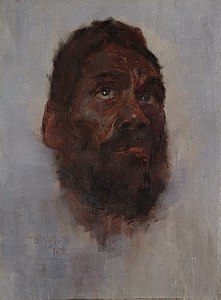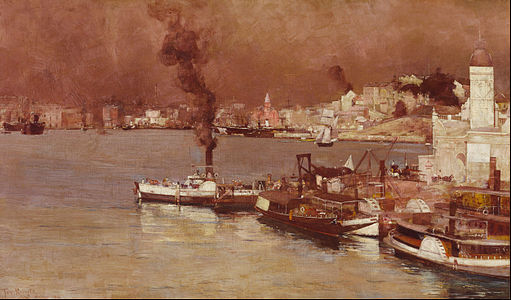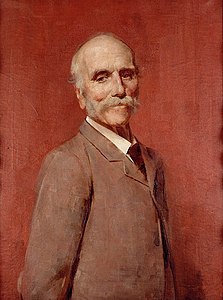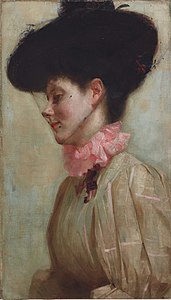Tom Roberts
Tom Roberts | |
|---|---|
 Roberts, c. 1895 | |
| Born | 8 March 1856 Dorchester, Dorset, England |
| Died | 14 September 1931 (aged 75) Kallista, Victoria, Australia |
| Resting place | Illawarra churchyard, near Longford, Tasmania |
| Occupation | Artist |
| Spouses | Elizabeth (Lillie) Williamson
(m. 1896–1928)Jean Boyes (m. 1928) |
Thomas William Roberts (8 March 1856 – 14 September 1931) was an English-born Australian artist and a key member of the Heidelberg School art movement, also known as Australian impressionism.
After studying in Melbourne, he travelled to Europe in 1881 to further his training, and returned home in 1885, "primed with whatever was the latest in art".[1] A leading proponent of painting en plein air, he joined Frederick McCubbin in founding the Box Hill artists' camp, the first of several plein air camps frequented by members of the Heidelberg School. He also encouraged other artists to capture the national life of Australia, and while he is best known today for his "national narratives"—among them Shearing the Rams (1890), A break away! (1891) and Bailed Up (1895)—he earned a living as a portraitist, and in 1903 completed the commissioned work The Big Picture, the most famous visual representation of the first Australian Parliament.
Life

Roberts was born in Dorchester, Dorset, England, although some mystery surrounds his actual birthdate: his birth certificate says 8 March 1856, whereas his tombstone is inscribed 9 March.[2]
Roberts migrated with his family to Australia in 1869 to live with relatives. Settling in Collingwood, a suburb of Melbourne, Victoria. He worked as a photographer's assistant through the 1870s, while studying art at night under Louis Buvelot and befriending others who were to become prominent artists, notably Frederick McCubbin.
During this period, his mother had remarried to a man whom Roberts did not get on with. He hence decided to further his art studies, and returned to England for three years of full-time art study at the Royal Academy Schools from 1881 to 1884. He traveled in Spain in 1883 with Australian artist John Russell, where he met Spanish artists Laureano Barrau and Ramon Casas who introduced him to the principles of Impressionism and plein air painting.[2] While in London and Paris, he took in the progressing influence of painters Jules Bastien-Lepage and James Abbott McNeill Whistler.[2]
From 1884 and through to February 1892,[3] Roberts worked again in Victoria, and from 1888 in the famous purpose-built studio complex of Grosvenor Chambers at 9 Collins Street, Melbourne.[4] He was a prominent member of the Buonarotti Club, adopting its bohemian habit of dress with a red satin lined opera cape and a 'crush topper,' though also advocating that professional artists be put in charge of the Club's exhibition activities; so instituted a selection panel of Frederick McCubbin, Louis Abrahams, John Mather, Jane Sutherland and himself, who would select and hang the works and provide exhibitors with constructive feedback.[5] In 1885 he started painting and sketching excursions to what would later become outer suburbs, creating camps at Box Hill and Heidelberg, where he worked alongside McCubbin, Arthur Streeton and Charles Conder, working on representing Australia's light, heat, space and distance.[2]

In 1896, he married 36-year-old Elizabeth (Lillie) Williamson and they had a son, Caleb. Many of his most famous paintings come from this period. Lillie Roberts was an expert maker of picture frames, and during the period 1903–1914, when Roberts painted relatively little, much of the family's income apparently came from Lillie's work. Roberts spent World War I in England assisting at a hospital. In Australia, he built a house at Kallista, near Melbourne. Elizabeth died in January 1928, and Roberts remarried, to Jean Boyes, in August 1928. He died in 1931 of cancer in Kallista near Melbourne. His ashes are buried in the churchyard at Illawarra near Longford, Tasmania
Work

Roberts painted a considerable number of fine oil landscapes and portraits, some painted at artist camps with his friend McCubbin. Perhaps the most famous in his time were two large paintings, Shearing the Rams, now displayed in the National Gallery of Victoria and The Big Picture, displayed in Parliament House, Canberra. The Big Picture, commissioned for a fee of one thousand guineas plus expenses[6] was a depiction of the first sitting of the Parliament of Australia in the Melbourne Exhibition Building and was an enormous work, notable for the event depicted as well as the quality of Roberts' work.
Shearing the Rams was based on a visit to a sheep station at Brocklesby in southern New South Wales, depicted the wool industry that had been Australia's first export industry and a staple of rural life. When it was first exhibited, there were immediately calls for the painting to enter a public gallery, with a Melbourne correspondent for the Sydney press stating, "if our national gallery trustees were in the least patriotic, they would purchase it."[7] Some critics did not feel that it fitted the definition of 'high art'. However, since the wool industry was Australia's greatest export industry at the time, it was a theme with which many Australian people could identify. In this painting, as one modern reviewer has said, Roberts put his formal art training to work, translating "the classical statuary into the brawny workers of the shearing shed".[8]
Roberts made many other paintings showing country people working, with a similar image of the shearing sheds in The Golden Fleece (1894),[9] a drover racing after sheep breaking away from the flock in A break away!, and with men chopping trees in Wood splitters (1886). Many of Roberts' paintings were landscapes or ideas done on small canvases that he did very quickly, such as his show at the famous 9 by 5 Impression Exhibition in Melbourne, "9 by 5" referring to the size in inches of the cigar box lids on which most of the paintings were done. Roberts had more works on display in this exhibition than anyone else.

In 1888 Roberts met Conder in Sydney and they painted together at Coogee beach. The younger Conder found these painting expeditions influential and decided to follow Roberts to Melbourne later that year to join him and Streeton at their artists' camp at Heidelberg. While Conder painted Coogee Bay emphasising on the decorative qualities of form and colour, Roberts' Holiday sketch at Coogee(1888) embodies his primary focus on the landscape's natural effects.[10] It is an early testament to Roberts' plein-air 'impressionist' technique, which brought out the sun's glare on the bright blue sea, bleached white sand, dry grass and spindly seaside vegetation.
Legacy
Roberts' life was dramatised in the 1985 Australian mini series One Summer Again.
A "lost" painting titled Rejected was featured in a 2017 episode of the BBC series Fake or Fortune?. It was determined by experts to be a genuine Roberts, dating from his student years in London. Roberts' granddaughter considered it a self-portrait. If so, it would make it his oldest surviving self-portrait.[11][12]
Retrospectives
A retrospective toured Australia in 1996–97 and another was shown at the National Gallery of Australia from December 2015 – March 2016.[8][13] Roberts was one of four Australian artists whose paintings featured in the Australia’s Impressionists exhibition at the National Gallery, London, which ran from December 2016 to March 2017; it was described as 'the first UK exhibition of its kind'.[14]
Gallery
- Tom Roberts's works
-
Rejected, 1883
-
Allegro con brio: Bourke Street west, 1886, National Gallery of Australia
-
Coming South, 1886, National Gallery of Victoria
-
Slumbering Sea, Mentone, 1887, National Gallery of Victoria
-
Aboriginal Head, Charlie Turner, 1892, Art Gallery of New South Wales
-
An autumn morning, Milson's Point, Sydney, 1888, Art Gallery of New South Wales
-
A break away!, 1891, Art Gallery of South Australia
-
Lily Stirling, 1890, National Gallery of Victoria
-
The Golden Fleece, 1894, Art Gallery of New South Wales
-
Mosman's Bay, 1894, New England Regional Art Museum
-
Edward Ogilvie, 1894–95, Tom Roberts, oil painting, State Library of New South Wales
-
Bailed Up, 1895, Art Gallery of New South Wales
-
Portrait of Florence, 1898, Art Gallery of New South Wales
See also
References
- ^ Diggins, Lauraine. The Australian Impressionists. Melbourne: Lauraine Diggins Fine Art, 1988. ISBN 0959274340, back cover
- ^ a b c d "Tom Roberts". AGNSW collection record. Art Gallery of New South Wales. Retrieved 6 April 2016.
- ^ "Topics Of The Day". Herald. 13 February 1892. p. 2. Retrieved 24 March 2023.
- ^ "An Australian Artist: A Little Talk With Mr Tom Roberts". Melbourne Punch. 9 May 1889. p. 11. Retrieved 24 March 2023.
- ^ Mead, Stephen F. (December 2011). "The Search for Artistic Professionalism in Melbourne: the activities of the Buonarotti Club, 1883 -1887". The Latrobe Journal. 88.
- ^ Helen Topliss, 'Roberts, Thomas William (Tom) (1856–1931)', Australian Dictionary of Biography, National Centre of Biography, Australian National University, https://adb.anu.edu.au/biography/roberts-thomas-william-tom-8229/text14405, published first in hardcopy 1988, accessed online 20 September 2022.
- ^ "Melbourne Gossip". The Sydney Mail and New South Wales Advertiser (Sydney). 19 July 1890. p. 145. Retrieved 18 March 2016.
- ^ a b McDonald, John (12 December 2015). "Review: John McDonald on Tom Roberts at the National Gallery of Australia, a break-away star". The Sydney Morning Herald. Retrieved 13 December 2015.
- ^ Roberts, Tom (1894). "The Golden Fleece". AGNSW collection record. Art Gallery of New South Wales. Retrieved 6 April 2016.
- ^ Roberts, Tom (1888). "Holiday sketch at Coogee". AGNSW collection record. Art Gallery of New South Wales. Retrieved 6 April 2016.
- ^ Chenery, Susan (3 September 2017). "Lost for 136 years: 'fake' Tom Roberts painting bought for £7,500 could sell for $1m". The Guardian. ISSN 0261-3077. Retrieved 6 September 2017.
- ^ "Tom Roberts, Series 6, Fake or Fortune? – BBC One". BBC. Retrieved 6 September 2017.
- ^ "Tom Roberts". National Gallery of Australia. Retrieved 13 December 2015.
- ^ "Australia's Impressionists | Past exhibitions | National Gallery, London". www.nationalgallery.org.uk. Retrieved 8 March 2021.
Further reading
- Croll, T.H. (1946) Smike to Bulldog : letters from Sir Arthur Streeton to Tom Roberts, Sydney, Ure Smith, (Sydney: Waite and Bull)
- Gray, Anne. Tom Roberts: La Vita Con Brio pp. 11–29, and Harmonic Arrangements: Tom Roberts' Painting pp. 31–58, in (2015) Tom Roberts, National Gallery of Australia, Canberra, ISBN 9780642334596
- Pearce, Barry (2000) Australian art in the Art Gallery of New South Wales, Art Gallery of New South Wales, Sydney, ISBN 0734763093
- Roberts, Tom. "Notebook, ca. 1894–1895" (1894-1895) [Note Book]. Tom Roberts Manuscripts, Series: MLMSS 1367, File: MLMSS 1367/3. NSW, Aus: State Library, State Library of New South Wales.
- Topliss, Helen. "Roberts, Thomas William (Tom) (1856–1931)". Australian Dictionary of Biography. Canberra: National Centre of Biography, Australian National University. ISBN 978-0-522-84459-7. ISSN 1833-7538. OCLC 70677943. Retrieved 5 June 2007.
- Topliss, Helen (1985). A Catalolgue Raisonne Volumes I and II. Oxford University Press, USA. p. 544. ISBN 0-19-554513-3.
External links
- 1856 births
- 1931 deaths
- Heidelberg School
- Paintings by Tom Roberts
- People from Dorchester, Dorset
- Artists from Melbourne
- British emigrants to the Colony of Victoria
- 19th-century Australian painters
- 19th-century English male artists
- 20th-century Australian painters
- 19th-century English painters
- English male painters
- 20th-century English painters
- Australian landscape painters
- Australian portrait painters
- Australian male painters
- 20th-century English male artists
- People from Collingwood, Victoria
- National Gallery of Victoria Art School alumni














